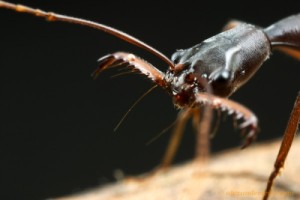The colorful ant pictured above is the ghost ant (Tapinoma melanocephalum). They aren’t actually brightly colored ants, but the opposite; they are translucent. I had never heard of these ants until the other day in lab when another student mentioned that they were his favorite ant. When I asked what they looked like, he told me they were translucent! Of course I was interested, so I googled them. As it turns out, only their gasters really are translucent. As you can see from the first picture above, when an ant drinks colored water, you can actually see the colored water inside of it!
I know, I wasn’t ready to believe it either. I really didn’t trust random internet sources and pictures until I found an article written about them on the Smithsonian museum’s website. (I figured they were a reliable source.)
From looking at these incredible photos these ghost ants seem pretty cool. However, to most people around the world, especially those living in Florida, they are commonly known for being pests. These ants are super tiny and average lengths between 1.3 and 2.0 millimeters. They use their small size to fit into nearly all cracks and crevices in the home. They multiply rapidly, plus the second half of their already tiny body is clear, so of course these ants are nearly impossible to see. Not to worry however, recently there has been significant progress in ghost ant pest control.
This next interesting ant is the trap-jaw ant (Odontomachus).
I am sure that now you can see why it is called the trap-jaw ant. Yeah, because of the giant pair of straight mandibles that stick 180 out of both sides of its face. The mandibles (jaws) are locked open by some type of internal mechanism. They snap shut if any type of prey touches the sensory hairs on the inside of their mandibles. Like other very predatory ants, like the army ants I talked about last week, these mandibles are used for killing or maiming prey. They also allow the ant to chop its food into smaller pieces so that they can bring it back to their nest.
These mandibles are impressive, they have the fastest moving predatory appendages within the entire animal kingdom! One study conducted showed these ants closing their mandibles with speeds between 78-143 mph. The jaws are so small that they close within 130 microseconds. Just as a reference, there are one million microseconds in just one second. Another reference, humans blink about 3 times per second. Theoretically these ants could close their jaws 7692 times per second.
Not only is the speed insane, but so is the force. The peak force exerted was in the order of 300 times the body weight of the ant. This is amazing; it’s like they are spring-loaded. Plus, these ants not only use these jaws for catching prey, but they also use them to escape from predators. These ants have been observed to use their jaws as a catapult to eject intruders or fling themselves backwards to escape a threat or a sting.
These ants can be found Central to South America, Asia, Australia, and Africa. Some ants of this species even live in the southern United States. These ants have been seen in Alabama, Florida, and the Gulf Coast. I guess a lot of ants live in Florida, and a lot of grandparents too. (That was a pun).

